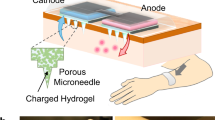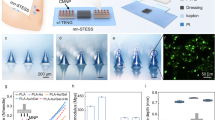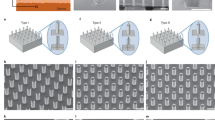Abstract
Electroporation (EP) is a simple in vivo method to deliver normally impermeable molecules, such as plasmid DNA, to a variety of tissues. Delivery of plasmid DNA by EP to a large surface area is not practical because the distance between the electrode pairs, and therefore the applied voltage, must be increased to effectively permeabilize the cell membrane. The design of the multielectrode array (MEA) incorporates multiple electrode pairs at a fixed distance to allow for delivery of plasmid DNA to the skin, potentially reducing the sensation associated with in vivo EP. In this report, we evaluate the effects of field strength and pulse width on transgene expression and duration using a plasmid encoding the luciferase reporter gene delivered by intradermal injection in a guinea pig model followed by EP with the MEA. As expected, the level of luciferase expression increased with the magnitude and duration of the voltage applied. In addition to adjusting transgene expression levels by altering fielding strength, levels could also be controlled by adjusting the plasmid dose. Our results indicate that the design of the MEA is a viable option for cutaneous plasmid DNA delivery by in vivo EP to a large surface area.
This is a preview of subscription content, access via your institution
Access options
Subscribe to this journal
Receive 12 print issues and online access
$259.00 per year
only $21.58 per issue
Buy this article
- Purchase on Springer Link
- Instant access to full article PDF
Prices may be subject to local taxes which are calculated during checkout




Similar content being viewed by others
References
Vogel JC . Nonviral skin gene therapy. Hum Gene Ther 2000; 11: 2253–2259.
Sersa G, Cemazar M, Semrov D, Miklavcic D . Changing electrode orientation improves the efficacy of electrochemotherapy of solid tumors in mice. Bioelectrochem Bioenerg 1996; 39: 61–66.
Gilbert RA, Jaroszeski MJ, Heller R . Novel electrode designs for electrochemotherapy. Biochim Biophys Acta 1997; 1334: 9–14.
Faurie C, Phez E, Golzio M, Vossen C, Lesbordes JC, Delteil C et al. Effect of electric field vectoriality on electrically mediated gene delivery in mammalian cells. Biochim Biophys Acta 2004; 1665: 92–100.
Heller LC, Jaroszeski MJ, Coppola D, Mccray AN, Hickey J, Heller R . Optimization of cutaneous electrically mediated plasmid DNA delivery using novel electrode. Gene Therapy 2007; 14: 275–280.
Heller LC, Jaroszeski MJ, Coppola D, Heller R . Comparison of electrically mediated and liposome-complexed plasmid DNA delivery to the skin. Genet Vaccines Ther 2008; 6: 16–23.
Ferraro B, Cruz YL, Coppola D, Heller R . Intradermal delivery of plasmid VEGF(165) by electroporation promotes wound healing. Mol Ther 2009; 17: 651–657.
Heller R, Cruz Y, Heller LC, Gilbert RA, Jaroszeski MJ . Electrically mediated delivery of plasmid DNA to the skin, using a multielectrode array. Hum Gene Ther 2010; 21: 357–362.
Ferraro B, Cruz YL, Baldwin M, Coppola D, Heller R . Increased perfusion and angiogenesis in a hindlimb ischemia model with plasmid FGF-2 delivered by noninvasive electroporation. Gene Therapy 2010; 17: 763–769.
Mershon MM, Mitcheltree LW, Petrali JP, Braue EH, Wade JV . Hairless guinea pig bioassay model for vesicant vapor exposures. Fundam Appl Toxicol 1990; 15: 622–630.
Sueki H, Gammal C, Kudoh K, Kligman AM . Hairless guinea pig skin: anatomical basis for studies of cutaneous biology. Eur J Dermatol 2000; 10: 357–364.
Lin W, Cormier M, Samiee A, Griffin A, Johnson B, Teng CL et al. Transdermal delivery of antisense oligonucleotides with microprojection patch (Macroflux) technology. Pharm Res 2001; 18: 1789–1793.
Heller R, Jaroszeski M, Atkin A, Moradpour D, Gilbert R, Wands J et al. In vivo gene electroinjection and expression in rat liver. FEBS Lett 1996; 389: 225–228.
Nishi T, Yoshizato K, Yamashiro S, Takeshima H, Sato K, Hamada K et al. High-efficiency in vivo gene transfer using intraarterial plasmid DNA injection following in vivo electroporation. Cancer Res 1996; 56: 1050–1055.
Aihara H, Miyazaki J . Gene transfer into muscle by electroporation in vivo. Nat Biotechnol 1998; 16: 867–870.
Heller LC, Heller R . In vivo electroporation for gene therapy. Hum Gene Ther 2006; 17: 890–897.
Bodles-Brakhop AM, Heller R, Draghia-Akli R . Electroporation for the delivery of DNA-based vaccines and immunotherapeutics: current clinical developments. Mol Ther 2009; 17: 585–592.
Gothelf A, Gehl J . Gene electrotransfer to skin; review of existing literature and clinical perspectives. Curr Gene Ther 2010; 10: 287–299.
Glasspool-Malone J, Somiari S, Drabick JJ, Malone RW . Efficient nonviral cutaneous transfection. Mol Ther 2000; 2: 140–146.
Drabick JJ, Glasspool-Malone J, King A, Malone RW . Cutaneous transfection and immune responses to intradermal nucleic acid vaccination are significantly enhanced by in vivo electropermeabilization. Mol Ther 2001; 3: 249–255.
Heller R, Schultz J, Lucas ML, Jaroszeski MJ, Heller LC, Gilbert RA et al. Intradermal delivery of interleukin-12 plasmid DNA by in vivo electroporation. DNA Cell Biol 2001; 20: 381.
Zhang L, Nolan E, Kreitschitz S, Rabussay DP . Enhanced delivery of naked DNA to the skin by non-invasive in vivo electroporation. Biochimica et BIOPHYSICA Acta-Gen Subj 2002; 1572: 1–9.
Babiuk S, Baca-Estrada ME, Foldvari M, Baizer L, Stout R, Storms M et al. Needle-free topical electroporation improves gene expression from plasmids administered in porcine skin. Mol Ther 2003; 8: 992–998.
Marti G, Ferguson M, Wang J, Byrnes C, Dieb R, Qaiser R et al. Electroporative transfection with KGF-1 DNA improves wound healing in a diabetic mouse model. Gene Therapy 2004; 11: 1780–1785.
Medi BM, Hoselton S, Marepalli RB, Singh J . Skin targeted DNA vaccine delivery using electroporation in rabbits. I: efficacy. Int J Pharm 2005; 294: 53–63.
Roos AK, Moreno S, Leder C, Pavlenko M, King A, Pisa P . Enhancement of cellular immune response to a prostate cancer DNA vaccine by intradermal electroporation. Mol Ther 2006; 13: 320–327.
Hooper JW, Golden JW, Ferro AM, King AD . Smallpox DNA vaccine delivered by novel skin electroporation device protects mice against intranasal poxvirus challenge. Vaccine 2007; 25: 1814–1823.
Vandermeulen G, Staes E, Vanderhaeghen ML, Bureau MF, Scherman D, Preat V . Optimisation of intradermal DNA electrotransfer for immunisation. J Control Release 2007; 124: 81–87.
Gao Z, Wu X, Song N, Cao Y, Liu W . Electroporation-mediated plasmid gene transfer in rat incisional wound. J Dermatol Sci 2007; 47: 161–164.
Hirao LA, Wu L, Khan AS, Satishchandran A, Draghia-Akli R, Weiner DB . Intradermal/subcutaneous immunization by electroporation improves plasmid vaccine delivery and potency in pigs and rhesus macaques. Vaccine 2008; 26: 440–448.
Liu L, Marti GP, Wei X, Zhang X, Zhang H, Liu YV et al. Age-dependent impairment of HIF-1alpha expression in diabetic mice: correction with electroporation-facilitated gene therapy increases wound healing, angiogenesis, and circulating angiogenic cells. J Cell Physiol 2008; 217: 319–327.
Andre F, Gehl J, Sersa G, Preat V, Hojman P, Eriksen J et al. Efficiency of high and low voltage pulse combinations for gene electrotransfer in muscle, liver, tumor and skin. Hum Gene Ther 2008; 19: 1261–1272.
Draghia-Akli R, Khan AS, Brown PA, Pope MA, Wu L, Hirao L et al. Parameters for DNA vaccination using adaptive constant-current electroporation in mouse and pig models. Vaccine 2008; 26: 5230–5237.
Martinon F, Kaldma K, Sikut R, Culina S, Romain G, Tuomela M et al. Persistent immune responses induced by a human immunodeficiency virus DNA vaccine delivered in association with electroporation in the skin of nonhuman primates. Hum Gene Ther 2009; 20: 1291–1307.
Vandermeulen G, Richiardi H, Escriou V, Ni J, Fournier P, Schirrmacher V et al. Skin-specific promoters for genetic immunisation by DNA electroporation. Vaccine 2009; 27: 4272–4277.
Roos AK, Eriksson F, Timmons JA, Gerhardt J, Nyman U, Gudmundsdotter L et al. Skin electroporation: effects on transgene expression, DNA persistence and local tissue environment. PLoS One 2009; 4: e7226.
Roos AK, Eriksson F, Walters DC, Pisa P, King AD . Optimization of skin electroporation in mice to increase tolerability of DNA vaccine delivery to patients. Mol Ther 2009; 17: 1637–1642.
Gothelf A, Hojman P, Gehl J . Therapeutic levels of erythropoietin (EPO) achieved after gene electrotransfer to skin in mice. Gene Therapy 2010; 17: 1077–1084.
Daugimont L, Baron N, Vandermeulen G, Pavselj N, Miklavcic D, Jullien MC et al. Hollow microneedle arrays for intradermal drug delivery and DNA electroporation. J Membr Biol 2010; 236: 117–125.
Hengge UR, Walker PS, Vogel JC . Expression of naked DNA in human, pig, and mouse skin. J Clin Invest 1996; 97: 2911–2916.
Heller L, Jaroszeski MJ, Coppola D, Pottinger C, Gilbert R, Heller R . Electrically mediated plasmid DNA delivery to hepatocellular carcinomas in vivo. Gene Therapy 2000; 7: 826–829.
Contag CH, Spilman SD, Contag PR, Oshiro M, Eames B, Dennery P et al. Visualizing gene expression in living mammals using a bioluminescent reporter. Photochem Photobiol 1997; 66: 523–531.
Acknowledgements
This research was supported in part by a research grant from the National Institutes of Health R01 EB005441 and by the Frank Reidy Research Center for Bioelectrics at Old Dominion University. We thank Dr Mark Jaroszeski (University of South Florida) for construction of the multielectrode array.
Author information
Authors and Affiliations
Corresponding author
Ethics declarations
Competing interests
With respect to duality of interest and financial disclosures, Dr R Heller is an inventor on patents, which cover the technology that was used in the work reported in this paper. One or more of the patents have been licensed to Inovio Pharmaceutical Corp. In addition, Dr R Heller owns stock and stock options in Inovio and has an ownership interest in RMR Technologies.
Rights and permissions
About this article
Cite this article
Ferraro, B., Heller, L., Cruz, Y. et al. Evaluation of delivery conditions for cutaneous plasmid electrotransfer using a multielectrode array. Gene Ther 18, 496–500 (2011). https://doi.org/10.1038/gt.2010.171
Received:
Revised:
Accepted:
Published:
Issue Date:
DOI: https://doi.org/10.1038/gt.2010.171
Keywords
This article is cited by
-
Safe and efficient novel approach for non-invasive gene electrotransfer to skin
Scientific Reports (2018)
-
Skin Electroporation of a Plasmid Encoding hCAP-18/LL-37 Host Defense Peptide Promotes Wound Healing
Molecular Therapy (2014)
-
Minicircle DNA electrotransfer for efficient tissue-targeted gene delivery
Gene Therapy (2013)
-
Intratumoral electroporation of IL-12 cDNA eradicates established melanomas by Trp2180–188-specific CD8+ CTLs in a perforin/granzyme-mediated and IFN-γ-dependent manner: application of Trp2180–188 peptides
Cancer Immunology, Immunotherapy (2012)
-
Molecular adjuvant HMGB1 enhances anti-influenza immunity during DNA vaccination
Gene Therapy (2011)



